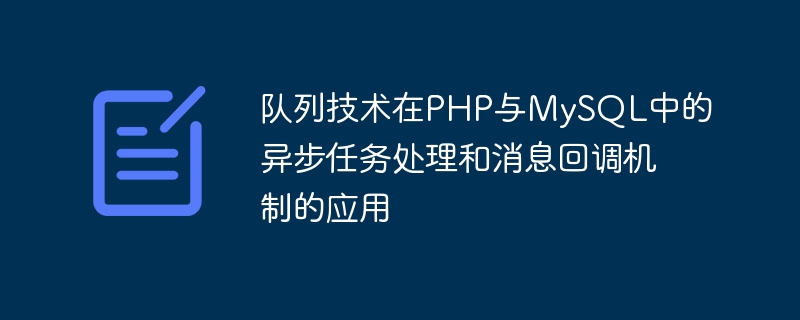Home >Backend Development >PHP Tutorial >Application of queue technology in asynchronous task processing and message callback mechanism in PHP and MySQL
Application of queue technology in asynchronous task processing and message callback mechanism in PHP and MySQL
- PHPzOriginal
- 2023-10-15 11:12:111105browse

Application of Queue Technology in Asynchronous Task Processing and Message Callback Mechanism in PHP and MySQL
With the rapid development of the Internet, user needs for websites and applications have also Higher and higher. In order to improve user experience and cope with the demand for high concurrent access, asynchronous task processing and message callback mechanisms have become an indispensable part of development. This article will introduce how to use queue technology to implement asynchronous task processing and message callback mechanisms in PHP and MySQL, and provide specific code examples.
- The concept of asynchronous task processing
In traditional synchronous processing, when the user initiates a request, the server will respond immediately and perform the corresponding operation. This will cause the request response time to be too long and easy. Causes server load to be too high. Asynchronous task processing transfers user requests to an independent task queue, which is processed by a dedicated worker thread, and the main thread immediately returns a response to the user, thus improving the concurrency and response speed of the system. - The combination of MySQL and queue technology
MySQL is a commonly used relational database that is widely used in various Web applications. In asynchronous task processing, MySQL can act as a task queue and store tasks in the database. Queue technology can realize asynchronous processing of tasks by monitoring the database.
The following is a sample code for asynchronous task processing based on MySQL and queue technology:
// 创建一个数据库连接
$mysqli = new mysqli('localhost', 'username', 'password', 'database');
// 向任务队列插入一个任务
function insertTask($taskName, $data) {
global $mysqli;
$stmt = $mysqli->prepare('INSERT INTO tasks (task_name, data) VALUES (?, ?)');
$stmt->bind_param('ss', $taskName, $data);
$stmt->execute();
}
// 监听任务队列并处理任务
function listenTasks() {
global $mysqli;
while (true) {
// 从数据库取出一个待处理任务
$stmt = $mysqli->prepare('SELECT * FROM tasks LIMIT 1');
$stmt->execute();
$result = $stmt->get_result();
$task = $result->fetch_assoc();
if ($task) {
// 处理任务
processTask($task['task_name'], $task['data']);
// 删除已处理的任务
$stmt = $mysqli->prepare('DELETE FROM tasks WHERE id = ?');
$stmt->bind_param('d', $task['id']);
$stmt->execute();
}
// 休眠一段时间后再继续监听
sleep(1);
}
}
// 处理任务的具体逻辑
function processTask($taskName, $data) {
// 根据任务类型执行相应的操作
// 示例:发送邮件
if ($taskName == 'send_email') {
sendEmail($data);
}
// 示例:生成PDF
if ($taskName == 'generate_pdf') {
generatePDF($data);
}
}
// 示例:发送邮件
function sendEmail($data) {
// 发送邮件的逻辑
}
// 示例:生成PDF
function generatePDF($data) {
// 生成PDF的逻辑
}
// 插入一个发送邮件的任务
insertTask('send_email', '邮件内容');
// 插入一个生成PDF的任务
insertTask('generate_pdf', 'PDF数据');
// 启动任务监听
listenTasks();In the above sample code, we first create a database connection and define the task The function of inserting tasks into the queueinsertTask. Then, we continuously monitor the tasks in the database through an infinite loop, and call the corresponding processing function processTask according to the task type to process the task.
- Application of message callback mechanism
In addition to asynchronous task processing, queue technology can also be combined with the message callback mechanism to implement more complex functions. The message callback mechanism refers to when a task is completed, the relevant code is notified through the callback function for subsequent processing.
The following is a sample code for a message callback mechanism based on MySQL and queue technology:
// 创建一个数据库连接
$mysqli = new mysqli('localhost', 'username', 'password', 'database');
// 注册回调函数
function registerCallback($taskName, $callback) {
global $mysqli;
$stmt = $mysqli->prepare('UPDATE tasks SET callback = ? WHERE task_name = ?');
$stmt->bind_param('ss', $callback, $taskName);
$stmt->execute();
}
// 监听任务队列并处理任务
function listenTasks() {
global $mysqli;
while (true) {
// 从数据库取出一个待处理任务
$stmt = $mysqli->prepare('SELECT * FROM tasks LIMIT 1');
$stmt->execute();
$result = $stmt->get_result();
$task = $result->fetch_assoc();
if ($task) {
// 处理任务
processTask($task['task_name'], $task['data']);
// 触发回调函数
if (!empty($task['callback'])) {
call_user_func($task['callback']);
}
// 删除已处理的任务
$stmt = $mysqli->prepare('DELETE FROM tasks WHERE id = ?');
$stmt->bind_param('d', $task['id']);
$stmt->execute();
}
// 休眠一段时间后再继续监听
sleep(1);
}
}
// 处理任务的具体逻辑
function processTask($taskName, $data) {
// 根据任务类型执行相应的操作
// 示例:发送邮件
if ($taskName == 'send_email') {
sendEmail($data);
}
// 示例:生成PDF
if ($taskName == 'generate_pdf') {
generatePDF($data);
}
}
// 示例:发送邮件
function sendEmail($data) {
// 发送邮件的逻辑
}
// 示例:生成PDF
function generatePDF($data) {
// 生成PDF的逻辑
}
// 注册一个任务完成后的回调函数
registerCallback('send_email', 'emailCallback');
// 任务完成后的回调函数
function emailCallback() {
// 发送邮件完成后的逻辑
}
// 插入一个发送邮件的任务
insertTask('send_email', '邮件内容');
// 启动任务监听
listenTasks();In the above sample code, we have added a new registerCallback Function, used to register the callback function after the task is completed. In the listenTasks function, when the task is completed, we trigger the registered callback function through the call_user_func function.
Summary:
This article introduces how to use queue technology in PHP and MySQL to implement asynchronous task processing and message callback mechanisms, and provides specific code examples. By using queue technology, the concurrency capability and response speed of the system can be improved to better meet user needs. At the same time, the message callback mechanism can implement more complex functions and provide more flexible processing methods. I hope this article will help you understand the application of queue technology.
The above is the detailed content of Application of queue technology in asynchronous task processing and message callback mechanism in PHP and MySQL. For more information, please follow other related articles on the PHP Chinese website!
Related articles
See more- Research on PHP real-time message queue technology
- Golang development: using coroutines to implement asynchronous task processing
- Implement distributed asynchronous task processing: using Celery Redis Django technology
- Application of queue technology in message timeout processing and message arrival guarantee in PHP and MySQL
- Application of queue technology in message persistence and message replay in PHP and MySQL

